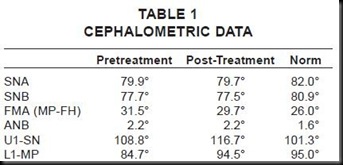be both difficult and problematic.1 First, the forces used to create space in the arch can oppose those needed to align the teeth. This can cause binding and notching of the wire at the locations of the most misaligned teeth, resulting in increased friction and thus negating the archwire’s superelastic
properties.2,3 Potentially harmful forces are also placed on the anchorage unit when aligning ectopic teeth.4 Furthermore, bonding brackets to the buccal
properties.2,3 Potentially harmful forces are also placed on the anchorage unit when aligning ectopic teeth.4 Furthermore, bonding brackets to the buccal
Diagnosis and Treatment PlanA 10-year-old girl presented with the chief complaint of unesthetic dental appearance
ectopically erupting maxillary right canine,
and retroclined maxillary right lateral incisor in crossbite before treatment.
and retroclined maxillary right lateral incisor in crossbite before treatment.
Although she had experienced a trauma to the maxillary left central incisor, there was no contraindication to orthodontic therapy. Intraoral examination revealed mild maxillary skeletal constriction,
crowding in the maxillary arch, and partial closure of the maxillary left lateral incisor eruption space due to the migration of adjacent teeth. A Class I molar relationship was present (Table 1),
crowding in the maxillary arch, and partial closure of the maxillary left lateral incisor eruption space due to the migration of adjacent teeth. A Class I molar relationship was present (Table 1),
but the mandibular dental midline was deviated to the left. The maxillary right canine was erupting ectopically, and the right lateral incisor was in crossbite and severely retroclined relative to the other upper incisors.
Two treatment options were considered. The first involved extraction of the maxillary premolars to resolve the crowding and allow the canines to erupt without flaring of the incisors.
The second option was to expand both arches by means of fixed appliances, with no extractions.
Two treatment options were considered. The first involved extraction of the maxillary premolars to resolve the crowding and allow the canines to erupt without flaring of the incisors.
The second option was to expand both arches by means of fixed appliances, with no extractions.
To maintain the patient’s profile, and because the maxillary expansion was expected to produce sufficient space for alignment, the second option was chosen.
Treatment Progress
Leveling and alignment were begun in the mandibular arch with full fixed appliances (Fig. 2).
Fig. 2 Self-ligating brackets bonded in lower arch for initial leveling and alignment.
Eight weeks later, the upper right canine had erupted enough to bond the maxillary teeth. We used self-ligating Bidimensional brackets6 (Time 2*) except on the retroclined lateral
incisor, where we bonded a stainless steel cleat to the lingual surface (Fig. 3).
incisor, where we bonded a stainless steel cleat to the lingual surface (Fig. 3).
Fig. 3 After eight weeks of treatment, self-ligating brackets bonded in upper arch, with stainless steel cleat
bonded to lingual surface of right lateral incisor.
bonded to lingual surface of right lateral incisor.
An extremely thin, flexible archwire (.012" nickel titanium) was inserted through the bracket slots and bent around the cleat to progressively align the teeth.
This method has several advantages. The forces used are extremely light, but effective because friction is controlled. Binding is prevented by limiting the wire to one-point contacts with the brackets and by increasin
This method has several advantages. The forces used are extremely light, but effective because friction is controlled. Binding is prevented by limiting the wire to one-point contacts with the brackets and by increasin











I feel happiness to read the content that you are posting. dentistry
ReplyDelete